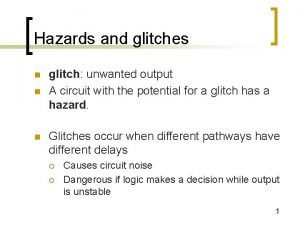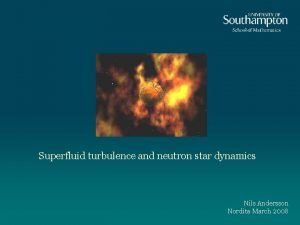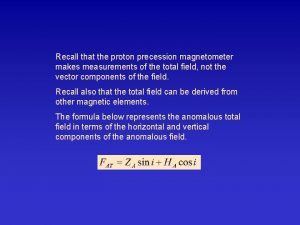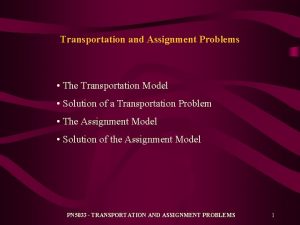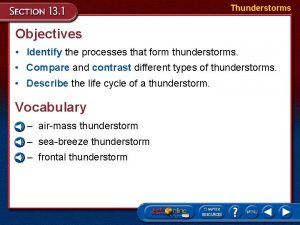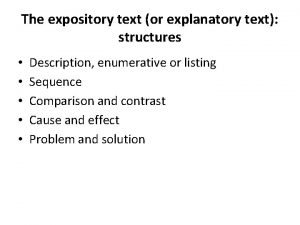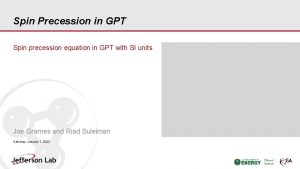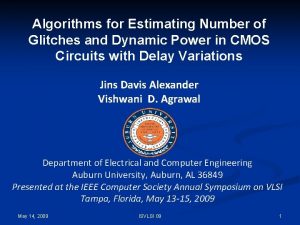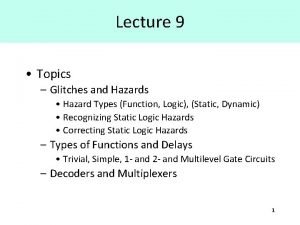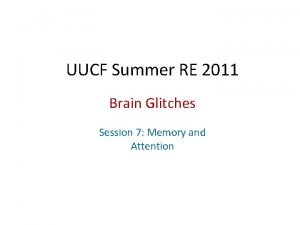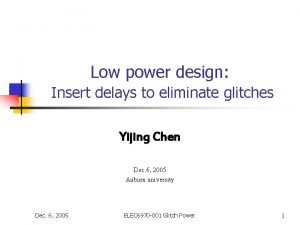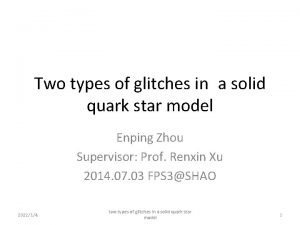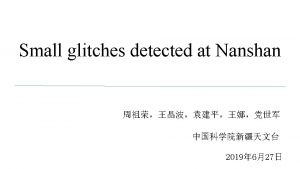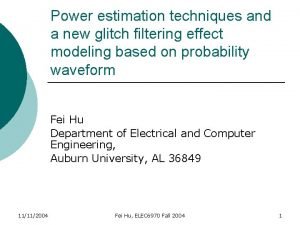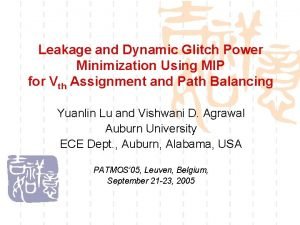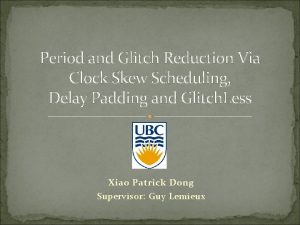Glitches and precession What is a glitch A

























































- Slides: 57

Glitches and precession

What is a glitch? A sudden increase of rotation rate (limits are down to <40 sec in Vela). ATNF catalogue gives >130 normal PSRs with glitches. The most known: Crab and Vela ΔΩ/Ω~10 -9 - 10 -6 Spin-down rate can change after a glitch. Vela is spinning down faster after a glitch. Starquakes or/and vortex lines unpinning new configuration or transfer of angular momentum Glitches are important because they probe internal structure of a NS. See a review in 1502. 07062

Anti-glitch of a magnetar AXP 1 E 2259+586 1305. 6894

Crab glitch and the general idea While the crust we see (and all coupled to it) is slowing down, some component of a star is not. Then suddenly (<40 sec) an additional momentum stored in such a “reservoir” is released and given to the crust. The crust spins-up, up the internal reservoir – down. Link et al. (2000) Lyne et al. (2000)

Glitches Starquakes or vortex lines unpinning. Unpinning of superfluid vortex lines results in a glitch. Vortex density is about 104 cm-2 P-1 Flux lines density is 5 1018 B 12 cm-2 Neutron vortices are confined in the crust. Proton superfluid is strongly coupled to the crust. A recent review about superfluidity in NS and its relation to glitches, etc. : 1709. 10340

Glitch discovery and observations 1211. 2035

The largest glitch of the Crab 2017 November 8 pulsar The glitch occurred after the longest period of glitch inactivity – 6 years, since beginning of daily monitoring in 1984. No changes in the shape of the pulse profile, no changes in the X-ray flux. 1805. 05110 (See theoretical discussion in 1806. 10168)

Glitch size – spin down rate correlation 1809. 07834

Phenomenology and the Vela pulsar Glitches are driven by the portion of the liquid interior that is differentially rotating with respect to the crust. Ic – crust + everything coupled with (i. e. , nearly all the star, except superfluid neutrons). The average rate of angular momentum transfer associated with glitches is - Pulsar activity parameter Vela glitches are not random, they appear every ~840 days. A – the slope of the straight line in the figure. (Values are for the Vela PSR) In Vela glitches can be related also to the outer core 1806. 10168

General features of the glitch Glitches appear because some fraction (unobserved directly) rotates faster mechanism than the observed part (crust plus charged parts), which is decelerated (i. e. , which is spinning-down). The angular momentum is “collected” by the reservoir, related to differentially rotating part of a star (SF neutrons) G – the coupling parameter. It can be slightly different in different sources. Glitch statistics for Vela provide an estimate for G. Superfluid is a good candidate to form a “reservoir” because relaxation time after a glitch is very long (~months) which points to very low viscosity. Link et al. 0001245

KERS Williams-F 1 used mechanical KERS. Energy is stored in a flywheel.

Critical velocity difference In most popular models glitches appear when the difference in angular velocity between the crust and the superfluid reaches some critical value. Isuper/Icrust ~ 10 -2 ΔΩ/Ω ~ 10 -6 ΔΩ – is for the crust (we see it!) ΔΩ Icrust = ΔΩsuper Isuper ΔΩsuper=ΔΩ Icrust/Isuper = Ω 10 -6 102 = 10 -4 Ω

Glitch size – waiting time correlation No correlation of a glitch size with time since the previous glitch, or with time before the next one. 1809. 03064

Eo. S and glitches Pt=0. 65 Me. V fm-3 nt=0. 075 fm-3 pressure and density on the core-crust boundary. Link et al. 0001245 See some critics in 1207. 0633 “Crust is not enough” and 1210. 8177 Further discussion – in 1404. 2660, 1809. 07834.

Which PSRs do glitch? On average young pulsars with larger spin-down glitch more frequently

P-Pdot >520 glitches in >180 PSRs Vela glitch in 1969 1801. 04332

Statistics 384 glitches in 141 NSs 1710. 00952 Catalogue http: //www. jb. man. ac. uk/pulsar/glitches. html

Glitches properties 384 glitches in 141 NSs 1710. 00952

1710. 00952

All PSRs in the survey are included, also those with no detected glitches. The double sum runs over every change in frequency ∆νij due to the glitch j of the pulsar i, and Ti is the time over which pulsar i has been searched for glitches. 1710. 00952

1710. 00952

The largest glitch 33 10 -6 1106. 5192

Glitch and radio properties PSR J 0742− 2822 exhibits two distinct emission states that are identified by discrete changes in the observed pulse profile. Correlation between frequency derivative and smoothed pulse shape parameter for overlapping 300 -day intervals. The vertical dashed line at MJD 55022 indicates the epoch of a glitch. Also shown with dotted bars is the same correlation when computed for the entire pre and post-glitch epochs. 1304. 4644

Thermal effect of a glitch Hirano et al. 1997

Gravitational waves from glitches In some very optimistic models GW signals from PSRs glitches can be detected already with existing detectors (a. LIGO, ad. VIRGO). For LIGO S 6 1305. 2466

Glitches of magnetars SGRs and AXPs are known to glitch. Several objects of both types showed one or several glitches. It is believed that magnetars’ glitches are different from PSRs’. The first was discovered in 2000: 1 RXS J 170849. 02400910 RXTE observations (Kaspi et al. 2000). About modeling of magnetar bursts see 1203. 4506: glitches always are accompanied by energy release.

Glitches and bursts Sometime magnetar glitches are related to bursts, sometime – not. The pulsed flux was nearly constant during glitches. 1 E 1841 -045 From Dib et al. 2008 RXS J 170849. 0 -400910

Glitch and bursts from PSR J 1119− 6127 Young highly magnetizes radio pulsar. Outburst with many flares. Glitch properties confirm the model of magnetospheric perturbation and energy release. Spin behavior correlates with pulse profile and spectral changes. 1806. 01414 (see also 1806. 05064)

PSRs vs. magnetars Nearly all known persistent AXPs now seem to glitch. In terms of fractional frequency change, AXPs are among the most actively glitch neutron stars, with glitch amplitudes in general larger than in radio pulsars. However, in terms of absolute glitch amplitude, AXP glitches are unremarkable. Dib et al. 2008

Are PSRs and magnetar glitches similar? It seems that for some AXP glitches G is much larger than for PSRs. Dib et al. propose that it can be related to the role of core superfluid. Many others proposed that glitches of magnetars can be related to magnetic field dissipation in the crust. As the field can be dynamically important there, its decay can result in crust cracking. Dib et al. (2008), see ar. Xiv: 0706. 4156

PSRs vs. Magnetars Glitch activity of the magnetars with the smallest characteristic ages is lower than that of the rotation-powered pulsars with similar characteristic ages. However, their activity is larger than that of pulsars of equal spin-down power. Magnetars PSRs

CCOs also glitch! 1809. 04678

Slow glitches Below: a slow glitch by PSR B 1822 -09 (Shabanova 1998) PSR B 0919+06 1007. 0125

Timing irregularities Analysis demonstrates different type of irregularities including quasi-periodic. 0912. 4537

Possible explanation? Magnetospheric effect? Two stages characterized by particular pulse profile and spin-down rate. Switching between these states happens rapidly. 1006. 5184

Polarization angle variations Such variations could be caused by precession Weisberg et al. 2010 1008. 0454

Precession in NSs Ω Pprec=P/ε, ε-oblateness: ε~10 -8 Pprec ~ year (More complicated models are developed, too. See Akgun, Link, Wasserman, 2005) 500 d Time of arrival and period residuals for PSR B 1828 -11. Wobbling angle is ~3 -5 o But why among ~1500 there are just 1 -2 candidates… ? New analysis confirms that PSR 1826 -11 can have precession (1510. 03579). Still, it is difficult to bring it in correspondence with glitches from this PSR (1610. 03509).

Precession (nutation) If we consider the free precession, then we have a superposition of two motions: Θw – is small Ω and L are very close 1. Rapid (~Ω) rotation around total angular momentum axis – L 2. Slow (Ωp) retrograde rotation around the symmetry axis (s) S Ω, L B θw B 0 χ Δφ=φmax-φmin=(χ+θw)-(χ-θw)=2θw Beam width variation See B. Link astro-ph/0211182

A toy model Ω flux S t B This is a picture seen by an external observer.

In the coordinate frame of the S B Ω body In this system the rotation axis is rotating around the symmetry axis. So, it is clear that the angle between spin axis and the magnetic axis changes. astro-ph/0211182 This results in an additional effect in timing: Now the spin-down rate changes with the period of precession.

Complications … A neutron star is not a solid body … At least crust contains superfluid neutron vortices. They are responsible for Ip~0. 01 of the total moment of inertia. There are several effects related to vortices. Neutron vortices can interact with the crust. So-called “pinning” can happen. The vortex array works as a gyroscope. If vortices are absolutely pinned to the crust then ωprec=(Ip/I)Ω~10 -2Ω (Shaham, 1977). But due to finite temperature the pinning is not that strong, and precession is possible (Alpar, Ogelman, 1987).

Superfluidity in NSs 50 years ago it was proposed (Migdal, 1959) that neutrons in NS interiors can be superfluid. Various baryons in neutron star matter can be in superfluid state produced by Cooper pairing of baryons due to an attractive component of baryon-baryon interaction. Now it is assumed that • neutrons are supefluid in the crust (singlet) • protons are superfluid in the core (singlet) • neutrons can also be superfluid in the core (triplet) Onsager and Feynman revealed that rotating superfluids were threaded by an array of quantized vortex lines.

Peculiar behavior of RX J 0720

RX J 0720. 4 -3125 as a variable source Long term phase averaged spectrum variations [Hohle et al. 2009 ar. Xiv: 0810. 5319] Phase dependent variations during different observations.

~10 years period: precession? ? ? 10. 711 +/-0. 058 yrs [Hohle et al. 2009] However, the situation is not clear. New results and a different timing solution. The estimate of the period of precession slightly changed down to ~7 years.

RX J 0720. 4 -3125: timing residuals -for P(t 0) and d. P/dt : phase coherent timing -in Kaplan & van Kerkwijk (2005) and van Kerkwijk 2007, without energy restriction -now: restricting to the hard band (except for ROSAT and Chandra/HRC ) +five new XMM-Newton +two new Chandra/HRC observations P(t 0)=8. 3911132650(91)s d. P/dt=6. 9742(19) 10 -14 s/s -long term period: (6. 91 +/- 0. 17) yrs Haberl (2007): (7. 70 +/- 0. 60) yrs for two hot spots: abs(sine) with 13 -15. 5 yrs period The slide from a talk by Markus Hohle (Jena observatory).

Another interpretation: glitch + ? Van Kerkwijk et al. astro-ph/0703326

RX J 0720. 4 -3125: a glitch 1203. 3708

Glitch+? in a PSR B 2334+61 ar. Xiv: 1007. 1143 Precession after a glitch was proposed as possible feature due to Tkachenko waves excitation (ar. Xiv: 0808. 3040 ). Precession as a viable mechanism for long-term modulation was recently discussed in details in 1107. 3503.

Free precession of a magnetar? The authors observe modulation of the pulse profile with a period ~15 hours. If it is interpreted by a free precession, than the NS is significantly deformed which can be due to strong toroidal field. This field might be ~1016 G. 1404. 3705

New precession candidates among Periodic modulations PSRs which can be interpreted as free precession. Correlations of the modulation period with spin period, characteristic age and spin-down power. 1510. 06078

Conclusion Many observed phenomena are related to internal dynamics of NSs. • Glitches • Precession Glitches are related to the existence of some reservoir for angular momentum. Most probably, it is a layer of superfluid neutrons in the inner crust. Some glitches of magnetars can be related to a different process.

Main papers • Link et al. astro-ph/0001245 Glitches • Link astro-ph/0211182 Precession • Jones, Andersson astro-ph/0011063 Precession • Dib et al. ar. Xiv: 0706. 4156 AXP glitches • Haskell, Melatos ar. Xiv: 1502. 07062 Big review • Haskell, Sedrakian ar. Xiv: 1709. 10340 Big review on superfluidity • Fuentes et al. ar. Xiv: 1710. 00952 Glitch statistics • Manchester ar. Xiv: 1801. 04332 Brief review on glitches

Many-many glitches … 1102. 1743 315 glitches in 102 PSRs

107 new glitches in 36 pulsars 1211. 2035

P–Pdot diagrams for glitch-related a) number of detected glitches; b) average quantities number of glitches per year; c) maximum fractional glitch size; d) maximum glitch size; e) rms fractional glitch size; and f) rms fractional size normalised by the mean. A circle indicates the parameter was obtained from the ATNF Pulsar Catalogue glitch table, whereas a triangle symbol indicates a parameter from this work. In the various plots, the seven pulsars exhibiting ten or more glitches are marked: 1 – PSR B 0531+21 (Crab pulsar); 2 – PSR J 0537− 6910; 3 – PSR B 0833− 45 (Vela pulsar); 4 – PSR J 1341− 6220; 5 – PSR J 1740− 3015; 6 – PSR J 0631+1036; 7 – PSR J 1801− 2304; and two magnetars: A – PSR J 1048− 5937 (1 E 1048. 1− 5937) and B – PSR J 1841− 0456 (1 E 1841− 045). 1211. 2035

Modeling glitches Mean field approach to describe vortex dynamics 1801. 01413
 Nss glitch
Nss glitch Glitch hazard
Glitch hazard Satisfactory slide glitch
Satisfactory slide glitch Precession milankovitch cycles
Precession milankovitch cycles Precession animation
Precession animation Larmor precession
Larmor precession Planes fly in which layer
Planes fly in which layer Précession des équinoxes animation
Précession des équinoxes animation Proton precession magnetometer
Proton precession magnetometer Red orange yellow green blue pink purple
Red orange yellow green blue pink purple Willaim blake
Willaim blake Romeo and juliet vs west side story venn diagram
Romeo and juliet vs west side story venn diagram Taller and younger and shorter and older
Taller and younger and shorter and older How to write 1000 pesos
How to write 1000 pesos Red orange green blue indigo violet
Red orange green blue indigo violet Gabby and sydney bought some pens and pencils
Gabby and sydney bought some pens and pencils Young and dyslexic text
Young and dyslexic text Albany movement
Albany movement West yorkshire health and care partnership
West yorkshire health and care partnership Whats a transverse wave
Whats a transverse wave Smkvqmuzwv4 -site:youtube.com
Smkvqmuzwv4 -site:youtube.com Independent variable and dependent variable
Independent variable and dependent variable Action verbs and linking verbs
Action verbs and linking verbs 5 life roles
5 life roles Importance of records and reports
Importance of records and reports Transportation and assignment problems
Transportation and assignment problems Compare and contrast cold wave and wind chill factor
Compare and contrast cold wave and wind chill factor Trading account vertical format
Trading account vertical format Lesson preparation siop
Lesson preparation siop Tomorrow and tomorrow
Tomorrow and tomorrow Ritz carlton credo
Ritz carlton credo Conglomerates and franchises 1950s
Conglomerates and franchises 1950s Gastrocnemius origin and insertion
Gastrocnemius origin and insertion Great gatsby chapter 1 summary
Great gatsby chapter 1 summary The giver chapter 3 quiz
The giver chapter 3 quiz What is an explanatory text
What is an explanatory text Definition of compare and contrast essay
Definition of compare and contrast essay Compare and contrast weather
Compare and contrast weather The boy in the striped pyjamas film analysis
The boy in the striped pyjamas film analysis The blind man and the elephant questions and answers
The blind man and the elephant questions and answers Hub and spoke airport
Hub and spoke airport What means compare and contrast
What means compare and contrast Input design in system analysis and design
Input design in system analysis and design Example of a pun in the most dangerous game
Example of a pun in the most dangerous game Complete subjects and complete predicates
Complete subjects and complete predicates What is the difference between and and or inequalities
What is the difference between and and or inequalities Soldering brazing and welding
Soldering brazing and welding A poem with similes and metaphors
A poem with similes and metaphors Similarities of parents
Similarities of parents Separation of powers and checks and balances
Separation of powers and checks and balances Security program and policies principles and practices
Security program and policies principles and practices Absolute maximum and minimum
Absolute maximum and minimum Megan and ron ate too much and felt sick
Megan and ron ate too much and felt sick Numbers rules
Numbers rules Hate theme in romeo and juliet
Hate theme in romeo and juliet Protagonist and antagonist in romeo and juliet
Protagonist and antagonist in romeo and juliet What is juliet prepared to do instead of marrying paris
What is juliet prepared to do instead of marrying paris Tricky dicky richard nixon
Tricky dicky richard nixon

